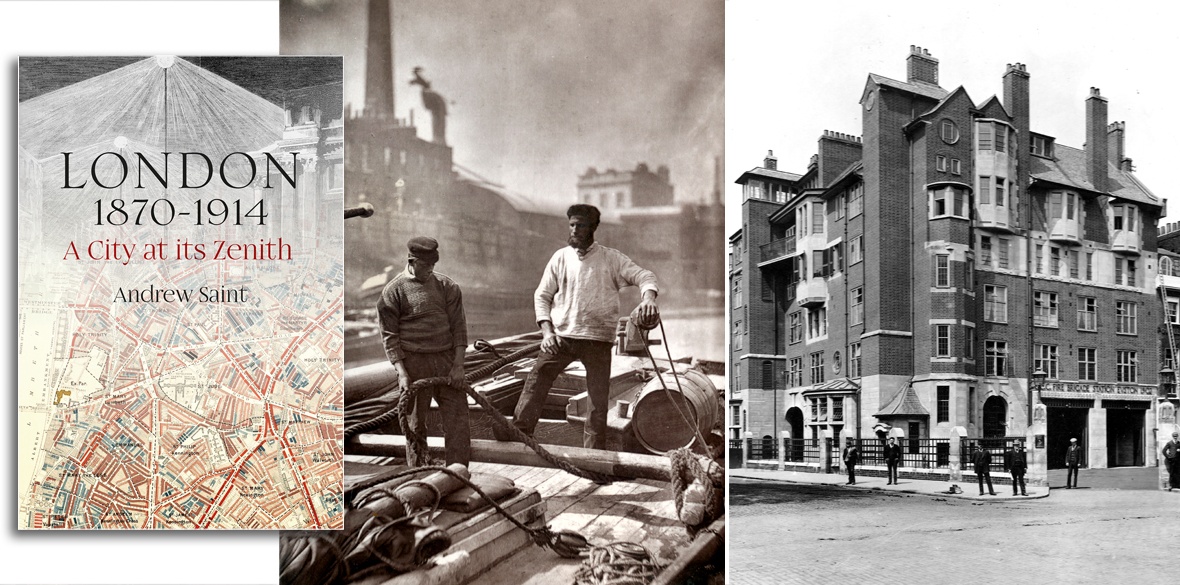This is the last article you can read this month
You can read more article this month
You can read more articles this month
Sorry your limit is up for this month
Reset on:
Please help support the Morning Star by subscribing here
London 1870-1910: City at its Zenith
by Andrew Saint
Lund and Humphries £24.43
THIS intriguing, informative, richly illustrated and engagingly written volume covers 40 years of a city living a epochal change, from the completion of the Joseph Bazalgette’s outfall sewers, switching London Underground to electric propulsion, the growth of trade unionism, birth of social democracy and … the first all-weather ice rinks made possible using a novel mixture of glycerine and water.
In a curious, and perhaps telling, coincidence, the period addressed is equivalent to the average lifespan for the time of just 41.8 years.
The agricultural depression meant that many sought refuge in London where overcrowding and poor sanitation caused much premature death.
Illustrators Blanchard Jerrold, Gustave Dore and photographers John Thomson and Adolphe Smith were on hand to provide compelling visual testimony.
Andrew Saint paints a broad urban panorama, animating it with architecture, arts, literature and politics. Each of the four decades is encapsulated in a self contained chapter and so the ’80s — the decade of coalescing socialist ideas — are announced by the death of Karl Marx and a simultaneous rise in social unrest.
Heady days for the Social(ist) Democratic Federation instigated by Henry Mayers Hyndman, aided and abetted by William Morris, George Bernard Shaw, Tom Mann, Harry Quelch and especially John Burns, a son of a Scottish railwayman from Battersea.
The decade also saw a mass migration, with the influx of poor Russian and Polish Jews escaping poverty and persecution, which met much hostility from the Establishment and would eventually lead to the Aliens Act in 1905.
The end of the tumultuous decade also saw the establishment of the London County Council in March 1889 in response the demands for a competent government for the whole of the city capable forward planning and running services effectively — none more important than addressing the dire housing situation, a mandate contained in the Housing of the Working Classes Act of 1890.
It wasn’t until 1893 when a second, and this time a radical, LCC was elected that change was set in motion. An Architect’s Department was established, lead by the legendary Owen Fleming, backed by a new in-house direct labour Council Works Department to circumnavigate the corruption and profiteering by private builders.
The architecturally impressive Boundary Street Estate, with Arnold Square at its centre to this day attests to the ambition and aspiration that inspired it almost 130 years ago.
Elsewhere, Australia commissioned the first purpose-built embassy by Aberdonian architects A Marshal MacKenzie, which remains he longest continuously occupied foreign mission in London, but with the redevelopment boom came much crudity and destruction as second-rate architecture proliferated.
EM Forster in his novel Howards End, published in 1910, cautioned against cosmopolitanism and the loss of heritage — a warning that might very well be voiced today far more vocally than it currently is.
In 1903 the Underground Central Line was inaugurated and the heyday of department stores begun answering and prompting middle-class consumerism.
But what of the poor? Perhaps the most significant achievement of the LCC came in reducing mortality rate of 20.9 per thousand in 1880s to 12.7 in 1910, smallpox was eradicated through vaccination and laws enacted against adulterating food.
Although the 1909 Royal Commission on the Poor Laws sat on the fence a minority report arguing for a structural understanding of poverty signalled a first step towards a welfare state which were reflected in the Liberal government’s groundbreaking Old Age Pensions Act of 1908 and National Insurance Act of 1911.
Saint’s page-turner chronicle offers an immersive historical perspective on many of the struggles that Londoners are facing today.









